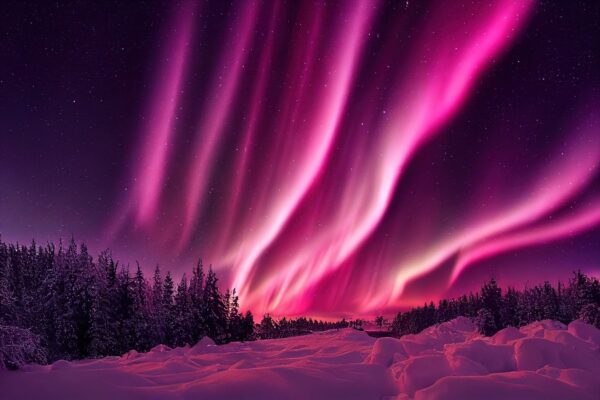Alaska’s vast, untamed wilderness offers countless wonders, but few experiences rival the ethereal beauty of the northern lights dancing across its dark skies. The aurora borealis is a bucket-list phenomenon for many travelers, and Alaska provides one of the most accessible and stunning settings to witness this natural marvel. Whether you’re a seasoned adventurer or a first-time visitor, understanding the best times, places, and planning considerations can make your aurora journey unforgettable. Marcy Gendel, an avid traveler with a deep appreciation for immersive experiences, highlights Alaska’s unparalleled charm for those seeking the northern lights.
Understanding the Aurora Borealis
The northern lights, or aurora borealis, are a result of charged solar particles colliding with Earth’s magnetic field, creating vibrant ribbons of color in the night sky. These celestial displays range from subtle green hues to dramatic cascades of red, purple, and yellow. Alaska’s high latitude and long winter nights make it an ideal location to view this phenomenon. Yet, capturing the aurora’s full brilliance requires more than luck—it’s a combination of timing, location, and preparation.
Timing Your Visit for Optimal Viewing
Timing is crucial when planning an aurora-viewing trip to Alaska. While the lights can technically occur year-round, they are best observed during Alaska’s dark winter months. The period from mid-September to late March offers the longest nights and clearest skies. Solar activity, which powers the auroras, also plays a significant role. Checking forecasts through resources like NOAA’s space weather prediction center or apps that monitor solar flares can greatly increase your chances of success.
Patience is key when chasing the aurora. While some nights burst with vibrant activity, others may pass quietly. Planning a trip over several days allows flexibility to work around unpredictable weather conditions and gives you a better shot at seeing a display.
The Best Places to See the Northern Lights in Alaska
Alaska’s geography provides numerous vantage points for aurora viewing, but some areas consistently stand out due to their minimal light pollution and clear skies. Fairbanks, often considered the aurora capital of Alaska, is a prime destination. Located within the auroral oval—a region encircling the magnetic north pole where activity is most concentrated—Fairbanks offers near-daily aurora visibility during the season.
For those seeking more remote experiences, areas like Coldfoot in the Brooks Range or the small town of Wiseman provide unparalleled serenity and minimal artificial light interference. Anchorage and its surrounding areas can also yield great results, particularly if you venture to darker locales like Eklutna Lake or the Turnagain Arm.
Choosing the Right Aurora Tour
For travelers who prefer guided experiences, Alaska boasts a variety of aurora tours tailored to different preferences and budgets. Options range from group bus tours to private excursions with photography experts. Guided tours often include perks such as heated viewing areas, professional camera setup assistance, and detailed explanations of the science behind the lights.
Some companies offer unique experiences, such as chasing the aurora by dog sled, snowmobile, or even aboard a private plane. These options can enhance your adventure and provide lasting memories. If photography is your focus, consider tours led by experts who provide tips on capturing the aurora’s brilliance.
Accommodations That Enhance the Experience
Where you stay during your aurora adventure can significantly influence your overall experience. Lodges and accommodations outside of urban areas provide not only darker skies but also unique settings to enjoy the lights in comfort. Many places near Fairbanks and beyond offer wake-up calls for guests when auroral activity is detected, ensuring you won’t miss the show.
Some remote lodges cater specifically to aurora enthusiasts, with amenities like glass-roofed cabins or domes for unobstructed views. Alternatively, staying in a city like Fairbanks or Anchorage and taking short drives to darker areas each night offers flexibility for those who prefer urban conveniences.
Tips for Maximizing Your Aurora Experience
Preparation is essential for a successful aurora chase in Alaska. Dressing warmly is a must, as temperatures can plunge well below freezing during the peak viewing season. Layered clothing, insulated boots, and proper hand and face coverings are critical to staying comfortable during extended periods outdoors.
Bringing the right equipment enhances the experience. A sturdy tripod, wide-angle lens, and manual settings on your camera are invaluable for capturing the aurora. For those new to aurora photography, taking a few practice shots at dusk can help familiarize you with your gear before the lights appear.
Finally, managing expectations is key. The aurora borealis is a natural phenomenon that operates on its own schedule. While planning and preparation greatly improve your chances, the unpredictability of nature remains part of its allure.
Reflecting on the Magic of the Northern Lights
There’s something profoundly humbling about standing beneath Alaska’s vast night sky, watching the northern lights weave their radiant dance across the heavens. The experience is more than just a visual spectacle; it’s a connection to the natural world and a reminder of the planet’s extraordinary beauty.
With careful planning, a spirit of adventure, and an appreciation for Alaska’s unique wilderness, you can create an aurora-viewing experience that stays with you long after the lights have faded. The northern lights are more than just a sight to see—they’re a journey to embrace, a story to tell, and a memory to treasure for a lifetime.
